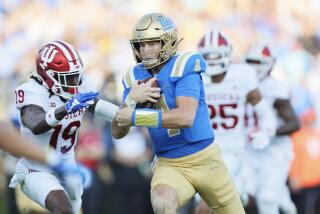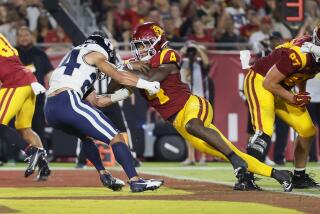UCSB Coach Possesses a Certain Savoir-Faire
Mark French smiles a lot, is quick with a quip and tells great stories.
What he doesn’t get is enough props for coaching basketball.
Since taking over at his alma mater in 1987, French has helped change UC Santa Barbara’s image from that of a beach school to one with a nationally respected program.
He has won 322 games at Santa Barbara -- 420 overall in 23 seasons -- using players of modest reputation. He has done it playing any team willing to play the Gauchos.
He has done it by taking chances.
This week, while many teams are waist-deep in conference play, the 20th-ranked Gauchos have games at Illinois and Louisiana State, games that hardly figure to be French pastry.
The Illini are 14-7 with legitimate dreams of reaching the NCAA tournament. Fourth-ranked LSU is 20-1, trails third-ranked Tennessee by half a game in the Southeastern Conference, and is undefeated at home.
Most teams wouldn’t risk playing two such difficult opponents consecutively this late in the season.
French sees things from another perspective.
“We have tried the last several years to play a couple of NCAA-caliber opponents [late] to get us in the mode of playing the kind of teams we need to beat,” he said.
“That’s not being critical of the Big West. But we also need this kind of challenge.”
The “challenge,” as French sees it, is to get his 17-3 team out of any late-season comfort zone.
Santa Barbara needs big games against physical teams in hostile environments, he said. Games in which the referees are less inclined to call fouls if there’s no blood on the floor.
They have to keep doing the things that make them winners, such as sealing off opponents from rebound position, setting strong screens for inside threat Lindsay Taylor and three-point specialist Jess Hansen, and playing the kind of stingy team defense that has opponents shooting 34.2%.
These games can raise the profile of a mid-major conference team such as Santa Barbara. But the payoff of a better NCAA tournament seeding comes only if you win -- or at least don’t get blown out.
Should French be worried that, if the trip turns out badly, the Gauchos will stagger through the rest of their season?
“I personally think there is enough recovery time,” French said. “I wouldn’t do games like this in March, two days before the Big West tournament, when it could disrupt chemistry and confidence.
“Whatever happens, we will have time to regroup. But if we aspire to meet the program goals we have set, we have to win one of these games, or we have a lot of work to do.”
He doesn’t expect his team to be intimidated. Not after the Gauchos knocked Louisiana Tech out of the 2002 NCAA tournament. Not after handing ninth-ranked Purdue one of its three defeats this season.
So it would be dangerous for Illinois or LSU to underestimate the little beach school coming to visit this week. Just as it’s dangerous to underestimate their easygoing, story-telling coach.
*
Last year during the NCAA selection committee meetings, Pac-10 representative Marie Tuite wanted to get three or four conference teams into the NCAA tournament.
But after Stanford and surprise Pac-10 tournament winner Arizona State, there wasn’t another team Tuite could make a convincing argument for. That included Washington, especially after the Huskies had lost their first-round Pac-10 tournament game to Oregon.
She should be in a stronger position now. Stanford, Washington, and Arizona are, or have been, nationally ranked. A fourth team could come from among UCLA, Arizona State, Oregon State and USC, depending on how they finish.
Tuite -- a senior associate athletic director at Washington -- said the Pac-10 should get more respect because nearly every team strengthened its nonconference schedule and, more important, won some of those games.
“Last year our nonconference performance was not what the coaches would have liked,” she said. “But we also had some young teams. This year we have a few more selling points.
“I still think the next few games and the conference tournament are really important to separate some teams out. But the bottom line is, we have [a stronger case] this year.”
Among the criteria used to pick the 64-team NCAA tournament are record, strength of schedule, season-ending performance, common opponents, and head-to-head competition.
What isn’t considered, Tuite said, is conference standing. For example, the committee can select a fifth-place team if it believes that team is better than the fourth-place team.
“The job is to pick the 31 best at-large teams, regardless of region or where you finished in conference,” Tuite said.
Meaning Tuite can go to the committee and campaign for multiple Pac-10 entries -- and not worry about being laughed out of the room.
More to Read
Go beyond the scoreboard
Get the latest on L.A.'s teams in the daily Sports Report newsletter.
You may occasionally receive promotional content from the Los Angeles Times.










